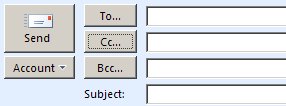
I just received an official e-mail from a security appliance manufacturer. The message was an official communication about their products line.
End of 2008 (almost 2009!), I’m really surprised how this communication was handled!
First, a Word document was attached to the message. Why? Word documents may carry viruses or malicious code, they are not signed and can be easily altered.
Second, the manufacturer sent his message to 92 recipients! All of them in the “To:” field. Of course, all recipients are coming from the same business: IT Security. I know head-hunters who will be very happy with such list. I also found that people were employed by another company. Perfect confidentiality! Let’s hope that nobody will click on “Reply to all” and start a nice Cc:-party.
Here are a few tips for a better communication via e-mail:
- Do not disclose the recipients list! Use the Bcc: field (Blind Carbon Copy)
- Keep your e-mail as light as possible. SMTP is not a file transfert protocol. More and more people will read your message on mobile device, so avoid big data transfers.
- Use an unalterable data format or sign your message using S/MIME or PGP. Best is a link to a web page (not all e-mail clients handle HTML code in the best way)
- A lot of SMTP servers limit the number of recipients per message to reduce spam. In this case, 92 is really too much.
Um, no thanks. I’d rather read a Word document than click on something like http://tracker.news04.example.com/readEmail.aspx?tag=blahBlAhbLahtHIsanDThaT0&recpt=grawity+fabrikam@gmail.tld&messageid=newsletter-advert-supercoolnewproduct-200802300, or something equally as ugly. (Besides, it doesn’t take very long to boot a Windows XP virtual machine, and open the Word document there.)